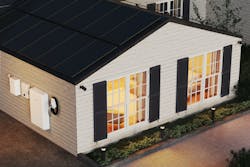For several years, driven by lucrative financial incentives, California saw a massive increase in solar installations. However, with the changes to the state’s net metering incentives introduced in April of last year, homeowners and installers of solar equipment alike are now trying to operate in the California solar industry’s “new normal.”
In recent years, the Golden State shined brightly, with solar at the forefront of its transformational shift to sustainable living. Leading the solar industry in the United States, the market grew exponentially, driven by the lucrative incentives available under the previous net energy metering (NEM) regulations — NEM 2.0.
However, in April, NEM 3.0 was put into place, bringing with it a drastic change to net metering rates that is projected to make it around 70% less profitable for homeowners to sell excess energy to the grid. Naturally, this has led to some market uncertainty with concerns about a possible dip in demand.
Recently, the California Public Utilities Commission (CPUC) rejected an overturn proposal on their recently proposed NEM 3.0 regulations — and even more recently decided to change net metering regulations further with the introduction of virtual net metering (VNEM). VNEM regulates how solar is used and credited on multimeter properties and is expected to make solar unprofitable for California small businesses, apartment renters, schools, and farms. With these decisions at the forefront of the solar industry’s mind, the industry is again debating what NEM 3.0 will mean for the solar market moving forward.
Leaning on the past to better understand the future
Fortunately for California, this situation is not new. Similar changes have occurred in many other countries across Europe. When energy becomes more expensive to buy than it is profitable to sell (as expected with NEM and VNEM), it is more cost-effective to store energy for personal use when the sun goes down. What you get is a net metering market shifting to a self-consumption market with solar + storage becoming the norm.
In both Belgium and Germany, for example, the same pattern emerged. Demand for solar increased significantly in the run-up to the tariff change and then dipped slightly afterward. However, in both countries, this proved to be a blip rather than a trend. Both countries have realized a substantial increase in demand for solar + storage installations, which has made these two markets very profitable for German solar installers.
Helping homeowners to prosper in a self-consumption market
With storage presenting a larger, long-term investment, homeowners will look for systems that offer a good value and will last. For installers, the key to maintaining sales is to add as much value for homeowners as possible. This starts by advising homeowners on the help available to reduce the cost of purchasing a solar + storage system.
The introduction of the Inflation Reduction Act (IRA) in 2022 brought with it rebates for energy efficiency retrofits of up to $4,000 for single-family homes and up to $400,000 for multifamily buildings, which can put a significant dent in the initial purchase price of the system. Even with this financial help, purchasing a solar + storage system may seem out of reach for some homeowners. Therefore, it is essential to offer a range of solutions to meet every budget. Currently, most batteries in the United States are purchased in combination with a backup unit. However, this is not essential for homeowners who are looking to store energy simply to increase their self-consumption.
Investing in a solar + storage solution will also be more appealing to homeowners educated on time of use (ToU) savings. Under NEM 3.0, export rates for solar energy will differ from hour to hour, which can make it difficult to determine the revenue homeowners can generate by selling energy back to the grid. On average, homeowners will receive about 5 cents/kWh. The exception is that during September between 6 p.m. and 8 p.m., the rate will increase to $3/kWh. This means that homeowners could receive a potential paycheck of $750 to $850 for September with careful management of the process.
Another way to add value for customers is to talk to them about the role that load shifting can play in increasing solar energy self-consumption. For example, scheduling heavier electrical loads such as EV chargers, heat pumps, pool pumps, and air conditioners to run at times when solar production is at its highest will help customers use much more of the energy produced by their home systems. This functionality will become even more important because of how EV charging increases the amount of energy required in homes. Therefore, offering a complete end-to-end smart energy management system within the home that automates this process will become a major selling point under NEM 3.0 and VNEM.
Oversizing PV arrays also becomes a more important consideration in a self-consumption market. Oversizing the array (in comparison to the inverter’s AC power) ensures that PV systems produce more power more of the time — even during low-light conditions. The result is a higher energy yield for the home and a faster return on investment for the homeowner through greater ToU savings and load shifting.
How installers can thrive in NEM 3.0
For solar installers to thrive in the new reality of a self-consumption market, they need to consider all battery options available and the factors that make installing batteries easier for themselves as well as beneficial to the customer.
A DC-coupled battery provides the highest efficiency energy storage by eliminating what is known as the “triple conversion penalty,” with two fewer power conversions required than AC-coupled batteries. In some cases, this can result in an additional 10 days of saved energy per year. Right now, homeowners are hyper-aware of how much their energy use is costing them, so it’s easy for them to quickly calculate how much extra savings this will generate.
However, the benefits of DC-coupled batteries also extend to installers. Unlike AC-coupled batteries, DC batteries do not require additional breakers to be installed in the home’s load center, which, in most cases, removes the need for a main panel upgrade (MPU). MPUs can be expensive for the homeowner and are extremely time-consuming for installers. Reducing the time it takes to complete each project means installers can move on to the next one much quicker, which is great news for their bottom line.
Long commissioning times for batteries are another source of frustration for installers. We often hear stories about batteries that can take up to a day to commission because of the time needed to upload firmware to the battery bank.
Will California stay golden?
While there’s no doubt the Californian solar market is undergoing a major change, it presents a huge opportunity for installers. As we’ve seen in other self-consumption markets that have experienced a similar shift, sales may dip in the short-term, but this will be followed by a resurgence in demand driven by solar + storage installations. The market that emerges will be more mature, stronger, and resilient. For installers who understand how to best implement batteries into their sales mix, they will be well positioned to become more profitable than ever.
About the Author

Chris Thompson
Chris Thompson is Vice President of Product and Technical Marketing at SolarEdge. In this role Chris manages the Grid Services, Technical Marketing and Regulatory functions in North America. Chris has over 30 years of diversified global experience in the power electronics and power systems markets, where he has worked globally, across Japan, Singapore, Canada and the US. Chris has held roles on all sides of the solar industry, from battery storage to inverter selection and on all scales, from residential to utility. Chris holds Bachelor’s Degrees with highest honors in both Mechanical and Electrical engineering from Tufts University, an MBA in Marketing and Finance from the University of Chicago, and a Master’s Degree in Electrical Engineering from the National University of Singapore where he served as a Fulbright Scholar. https://www.linkedin.com/in/solarchris/


